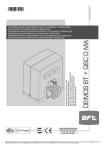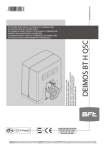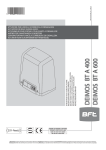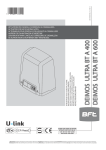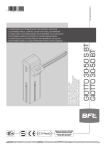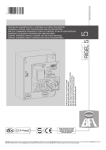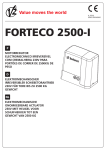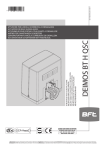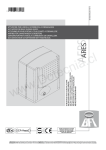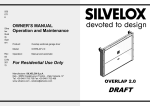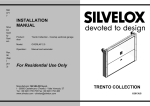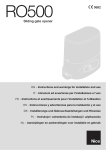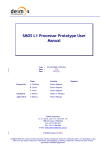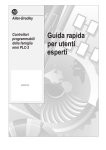Download - Egates Knowledge Base
Transcript
D811788 00100_01 03-05-11 027908 391087 DEIMOS BT H QSC DEIMOS ATTUATORE PER CANCELLI SCORREVOLI A CREMAGLIERA ACTUATOR FOR RACK SLIDING GATES ACTIONNEUR POUR PORTAILS COULISSANTS A CREMAILLERE ANTRIEB FÜR ZAHNSTANGEN-SCHIEBETORE SERVOMOTOR PARA CANCELAS CORREDERAS DE CREMALLERA ACTUATOR VOOR SCHUIFHEKKEN MET TANDHEUGEL ISTRUZIONI D’USO E DI INSTALLAZIONE INSTALLATION AND USER’S MANUAL INSTRUCTIONS D’UTILISATION ET D’INSTALLATION INSTALLATIONS-UND GEBRAUCHSANLEITUNG INSTRUCCIONES DE USO Y DE INSTALACION INSTALLATIEVOORSCHRIFTEN 8 Attenzione! Leggere attentamente le “Avvertenze” all’interno! Caution! Read “Warnings” inside carefully! Attention! Veuillez lire attentivement les Avertissements qui se trouvent à l’intérieur! Achtung! Bitte lesen Sie aufmerksam die „Hinweise“ im Inneren! ¡Atención¡ Leer atentamente las “Advertencias” en el interior! Let op! Lees de “Waarschuwingen” aan de binnenkant zorgvuldig! A B > 25mm 3x1mm2 2 mm ,75 5x0 3x 3x1 1.5 mm 2 .5m m2 2x0.75mm2 3x1.5mm2 “X”= 2x1.5mm2 RG58 3x1.5mm2 PREDISPOSIZIONE TUBI, TUBE ARRANGEMENT, PRÉDISPOSITION DES TUYAUX, VORBEREITUNG DER LEITUNGEN, DISPOSICIÓN DE TUBOS, VOORBEREIDING LEIDINGEN. > 10mm Cremagliera, Rack, Crémaillère, Zahnstange, Cremallera, Tandheugel 25mm + “X” Predisposizione fissaggio motore, Preparation for motor mounting, Aménagement fixation moteur, Vorbereitung Motorbefestigung, Disposición fijación del motor, Voorbereiding bevestiging motor. C D Y Montaggio motore, Mounting the motor, Montage moteur, Montage Motor, Montaje del motor, Montage motor. D1 Y E Montaggio accessori trasmissione, Mounting drive accessories, Montage accessoires transmission, Montage Antriebszubehör, Montaje de accesorios transmisión, Montage accessoires overbrenging. F Fissaggio staffe finecorsa (dx e sx), Fastening limit switch brackets (RH/LH), Fixation étriers fin de course (drt et gch), Befestigung Bügel Anschläge (rechts und links), Fijación abrazaderas final de carrera (der. e izq.), Bevestiging stangen aanslag (rechts en links). 2 - DEIMOS BT H QSC Collegamento morsettiera, Terminal board wiring, Connexion plaque à bornes, Anschluss Klemmleiste, Conexión tablero de bornes, Aansluiting aansluitkast. D811788 00100_01 INSTALLAZIONE VELOCE-QUICK INSTALLATION-INSTALLATION RAPIDE SCHNELLINSTALLATION-INSTALACIÓN RÁPIDA - SNELLE INSTALLATIE SWC NC SWO 25W max. ANT 0V(-) 24V ~(+) SCA/2°CH VSAFE ~(-) FAULT PHOT NO COM PED NO COM START/CLOSE NO STOP NC PHOT NC BAR NO OPEN FAULT BAR NO Connettore programmatore palmare, Palmtop programmer connector, Connecteur programmateur de poche, Steckverbinder Palmtop-Programmierer, T 230V F1 1,6A 3,15A T 120V 31 32 33 34 Conector del programador de bolsillo, Connector programmeerbare palmtop DEUTSCH NC Connettore scheda opzionale Optional board connector Connecteur carte facultative Steckverbinder Zusatzkarte Conector de la tarjeta opcional Connector optionele kaart FRANÇAIS VSAFE ~(+) Display + Programmierungstasten Pantalla + botones programación Display + programmeringstoetsen ENGLISH NC Display + tasti programmazio ne Display + programming keys JP1 COM F2 3,15A T 230V~ 24V ~ (+) JP2 2 1 0V (-) 27 26 25 24 23 22 21 20 19 18 17 16 15 14 13 12 11 10 9 8 7 6 5 4 3 M Led presenza alimentazione Power ON LED Del de présence de tension LED Stromversorgung vorhanden Led presencia de alimentación Led aanwezigheid voeding Connection of 1 pair of non-tested photocells N L Anschluss von einem Paar nicht überprüften Fotozellen Conexión de 1 par fotocélulas no comprobadas Aansluiting van 1 paar fotocellen anders dan “trusted device” SCA JP9 JP9 13 12 II° CH 14 15 14 15 12 13 24V ~ 21 COM 1 PHOT 24 5 4 3 2 1 ESPAÑOL 24V~ H JP3 2 1 Rx 1 Tx 1 LOGICA test fotocellule OFF/ Photocell test LOGIC OFF LOGIQUE essai photocellules Désactivée / LOGIK Test Fotozellen OFF LÓGICA prueba fotocélulas OFF / LOGICA test fotocellen OFF DEIMOS BT H QSC - 3 NEDERLANDS 24 V~ Grigio-Grey-Gris-Grau-Gris-Grijs Grigio-Grey-Gris-Grau-Gris-Grijs D811788 00100_01 ITALIANO G D811788 00100_01 SIMPLIFIED MENU x1 PRESET DEFAULT ar sr ac sc ind PARAMETERS language Automatic Closing Time Slow-down speed ITA fra deu eng rh : motor installed on the right rh lh : motor installed on the left lh preset 40 40 40 40 40 15 15 15 15 15 15 Opening motor torque 75 75 75 75 75 75 Closing motor torque 75 75 75 75 75 75 Speed during opening 99 99 99 99 99 99 Speed during closing 99 99 99 99 99 99 Partial opening 40 40 40 40 40 40 Zone 0 0 0 0 0 0 Slow-down distance 0 0 0 0 0 0 Opening deceleration space 10 10 10 10 10 10 Closing deceleration space 10 10 10 10 10 10 LOGIC esp dir 40 ar: automatic operation, residential AR sr: semiautomatic operation, residential sr ac: automatic operation, commercial ac Automatic Closing Time OFF ON OFF ON OFF OFF Block Pulses OFF OFF OFF ON ON OFF Impulse lock TCA OFF OFF OFF OFF OFF OFF 3 step OFF ON OFF ON OFF OFF Pre-alarm OFF OFF OFF ON ON OFF Deadman OFF OFF OFF OFF OFF ON Photocells during opening OFF ON ON ON ON OFF Photocell test OFF OFF OFF OFF OFF OFF Safety edge testing OFF OFF OFF OFF OFF OFF Master/Slave OFF OFF OFF OFF OFF OFF Fixed code OFF OFF OFF OFF OFF OFF Remote control programming ON ON ON ON ON ON Gate open light or 2nd radio channel OFF OFF OFF OFF OFF OFF START - CLOSE setting OFF OFF OFF OFF OFF OFF - - - - - - OFF OFF OFF OFF OFF OFF Reversing motion ICE Sc: semiautomatic operation, commercial sc Ind:dead man operation ind MIN 1 - MAX 3 autoset AUTO OPEN . . . . . . o AUTO CLOSE o Scroll up e re otes hidden button release desidered button O 01 Scroll down Confirm/Switch on display Exit Menù end DEIMOS BT H QSC - 5 L 40 30 60 22 28 6 12 265 22 37 50 122 28 22 118 0 43 16 131 CFZ 249 CP CVZ N M OK NO O >25 50 >100 2mm P 25 O1 R Q 88 88 P1 P2 S 10 - DEIMOS BT H QSC D811788 00100_01 K D811788 00100_01 S 88 SCHEDA DI ESPANSIONE EXPANSION BOARD CARTE EXPANSION ERWEITERUNGSKARTE TARJETA DE EXPANSIÓN UITBREIDINGSKAART 88 UNIDA Programmeerbare Universele Palmtop Connessione seriale per ante contrapposte, Serial connection for opposite leaves, Connexion série pour vantaux opposés, Serieller Anschluss für einander entgegengesetzte Torflügel, Conexión serial para hojas contrapuestas, Seriële verbinding voor tegenovergestelde vleugels. RX1 (PHOT) BAR2 BAR1 T TX1 (PHOT) M2 SLAVE M1 MASTER TX2 (PHOT) RX2 (PHOT) zone=128 aster=ON zone=128 aster=OFF NC NC NO NO ANT 0 V(-) COM SWO 24V 25W Max SWC 24 V~ + V Safe - SCA/2°CH V Safe + FAULT-PHOT COM PED COM ST ART/CLOSE STOP PHOT BAR1 OPEN FAULT-BAR 1 SWO COM SWC 24V 25W Max 0 V(-) 24 V ~ + V Safe V Safe + COM BAR2 2 1 NO NC NC NC NO NO NC NC NC FAULT-BAR 2 27 26 25 24 23 22 21 20 19 18 17 16 15 14 13 12 11 10 9 8 7 6 5 4 3 27 26 25 24 23 22 21 20 19 18 17 16 15 14 13 12 11 10 9 8 7 6 5 4 3 JP2 2 1 JP2 31 32 33 34 31 32 33 34 JP1 JP1 TX TX RX RX TX TX RX RX SCS1 SCS1 Connessione Seriale Mediante Scheda Scs1 , Serial Connection Via Scs1 Card, Connexion Série À Travers La Carte Scs1, Serielle Verbindung Mit Karte Scs1, Conexión Serial Mediante Tarjeta Scs1, Seriële Verbinding Middels Kaart Scs1. SLAVE SLAVE MASTER U DEIMOS BT H QSC - 11 PHOTOCELLS FOTOCÉLULAS PHOTOCELLULES FOTOCELLEN COSTE LEISTEN SAFETY EDGES CANTOS LINTEAUX RANDEN V 27 26 25 24 23 22 21 20 19 18 17 16 15 14 13 12 1 2 TX1 1 2 3 RX1 1-PHOT 13 12 21 18 24 4 5 TEST PHOT = ON 3 17 16 1 2 TX1 RX1 2-PHOT 17 16 17 16 4 1 2 1 2 TX2 RX2 TX1 RX1 3-PHOT 17 16 17 16 17 16 5 1 2 1 2 1 2 TX2 RX2 TX3 RX3 RX1 TX1 4-PHOT 17 16 17 16 17 16 1 2 1 2 1 2 RX2 TX2 RX3 TX3 RX4 TX4 1 2 3 4 5 13 12 1 2 3 4 5 13 12 17 25 27 21 12 13 6 5 4 3 2 1 Bar 1 17 25 21 12 13 21 24 13 12 1 2 3 4 5 13 12 1 2 3 4 5 13 12 3-SCS1-MA 18 21 21 24 2-SCS1-MA 1-SCS1-MA 1 2 3 4 5 13 12 1 2 3 4 5 13 12 1 2 3 4 5 13 12 3-SCS1-MA 5-SCS1-MA 4-SCS1-MA 1 2 3 4 5 13 12 6-SCS1-MA 18 21 21 24 2-SCS1-MA 1-SCS1-MA 1-BAR B 1-BAR C 6 5 4 3 2 1 Bar 1 2-BAR 17 21 27 18 21 1 2 3 4 5 A 12 13 17 25 21 12 13 17 4-SCS1-MA 5-SCS1-MA 12 13 6 5 4 3 2 1 Bar 1 6 5 4 3 2 1 Bar 2 6 5 4 3 2 1 Bar 2 3-BAR D 17 21 27 6-SCS1-MA 12 13 6 5 4 3 2 1 Bar 3 4-BAR 17 25 21 12 13 17 1-SCS1-MA 2-SCS1-MA 12 13 6 5 4 3 2 1 Bar 1 6 5 4 3 2 1 Bar 2 TEST BAR = OFF TEST PHOT = OFF 24 21 12 13 6 5 4 3 2 1 Bar 1 13 25 17 4-SCS1-MA 5-SCS1-MA 3-SCS1-MA 12 13 17 21 27 6-SCS1-MA 12 13 6 5 4 3 2 1 Bar 3 TEST BAR = ON 17 16 5 4 0V(-) 2 13 12 21 24V ~(+) 1-PHOT 1 2 3 Vsafe - RX1 Vsafe + TX1 FAULT PHOT COM 1 2 COM BAR 13 12 PHOT FAULT BAR 1 E 6 5 4 3 2 1 Bar 4 Numero massimo dispositivi collegabili, Maximum number of devices that can be connected, Nombre maximum de dispositifs pouvant être connectés, Max. Anzahl der anschließbaren Geräte, Número máximo dispositivos que se pueden conectar, Maximum aantal aansluitbare inrichtingen. TEST BAR=ON / TEST PHOT=ON FOTOCELLULE PHOTOCELLULES 12 - DEIMOS BT H QSC FOTOCÉLULAS FOTOZELLEN PHOTOCELLS FOTOCELLEN LEISTEN CANTOS COSTE LINTEAUX SAFETY EDGES RANDEN 3 E 5 C D811788 00100_01 FOTOCELLULE FOTOZELLEN x2 Scroll up Scroll down Confirm/Switch on display para . 1 See PARAMETERS MENU Exit Menù para . 2 para . . . . logic logic. 1 See LOGIC MENU logic. 2 logic. . . . radio add. start hidden button release desired button ok 01 Add. 2ch hidden button release desired button ok 01 See RADIO MENU PRG. erase 64 +/COD RX 1A9C OK 22FD OK 01 OK v DIAGNOSTICS and WARNINGS PRG default ITA language DIAGNOSTICS CODE ped STRE stop phot bar OK - + FRA OK - + DEU OK - + ENG bar2 OK cls open svo svc - + esp OK autoset set stat vers OK OK bft . . . +/n. cycles OK 0000 +/- Er02 Er05 - + n. Re otes OK Er1x* er3x* Er4x* 00 +/- NOTES pedestrian input activated START input activated STOP input activated attivazione ingresso PHOT SAFETY EDGE input activated SAFETY EDGE input activated on slave motor (opposite leaves connection) CLOSE input activated OPEN input activated opening limit switch input activated closing limit switch input activated the board is standing by to perform a complete opening-closing cycle uninterrupted by intermediate stops in order to acquire the torque required for movement. WARNING! Obstacle detection function is not active check photocell connection and/or logic settings check safety edge connection and/or safety edge test error logic settings safety edge test error on slave motor (opposite check safety edge connection and/or leaves connection) parameter/logic settings board hardware test error check connections to motor reverse due to obstacle check for obstacles in path thermal cutout error Allow motor to cool anomaly in communication w/ remote de- check Scs1 serial connections vices running off battery -limit switch error check limit switch connections photocell test error Er01 - + DESCRIPTION Er5x* ER61 ErFx* Fig.2 * X = 0,1,…,9,A,B,C,D,E,F 35.40 Set torque threshold Maximum instantaneous motor torque Closing Opening B A F C 18 - DEIMOS BT H QSC D F E C D811788 00100_01 ACCESS TO MENUS Fig. 1 D811788 00100_01 INSTALLER WARNINGS WARNING! Important safety instructions. Carefully read and comply with all the warnings and instructions that come with the product as incorrect installation can cause injury to people and animals and damage to property. The warnings and instructions give important information regarding safety, installation, use and maintenance. Keep hold of instructions so that you can attach them to the technical file and keep them handy for future reference. CHECKING THE AUTOMATED SYSTEM AND MAINTENANCE Before the automated system is finally put into operation, and during maintenance work, perform the following checks meticulously: - Make sure all components are fastened securely. - Check starting and stopping operations in the case of manual control. - Check the logic for normal or personalized operation. - For sliding gates only: check that the rack and pinion mesh correctly with 2 mm of play; keep the track the gate slides on clean and free of debris at all times. - Check that all safety devices (photocells, safety edges, etc.) are working properly and that the anti-crush safety device is set correctly, making sure that the force of impact measured at the points provided for by standard EN 12445 is lower than the value laid down by standard EN 12453. - Make sure that the emergency operation works, where this feature is provided. - Check opening and closing operations with the control devices applied. - Check that electrical connections and cabling are intact, making extra sure that insulating sheaths and cable glands are undamaged. - While performing maintenance, clean the photocells’ optics. - When the automated system is out of service for any length of time, activate the emergency release (see “EMERGENCY OPERATION” section) so that the operated part is made idle, thus allowing the gate to be opened and closed manually. SCRAPPING Materials must be disposed of in accordance with the regulations in force. There are no particular hazards or risks involved in scrapping the automated system. For the purpose of recycling, it is best to separate dismantled parts into like materials (electrical parts - copper - aluminium - plastic - etc.). DISMANTLING If the automated system is being dismantled in order to be reassembled at another site, you are required to: - Cut off the power and disconnect the whole electrical system. - Remove the actuator from the base it is mounted on. - Remove all the installation’s components. - See to the replacement of any components that cannot be removed or happen to be damaged. Anything that is not explicitly provided for in the installation manual is not allowed. The operator’s proper operation can only be guaranteed if the information given is complied with. The Firm shall not be answerable for damage caused by failure to comply with the instructions featured herein. While we will not alter the product’s essential features, the Firm reserves the right, at any time, to make those changes deemed opportune to improve the product from a technical, design or commercial point of view, and will not be required to update this publication accordingly. AVVERTENZE PER L’INSTALLATORE D811766_03 DEIMOS BT H QSC - 19 ENGLISH GENERAL SAFETY This product has been designed and built solely for the purpose indicated herein. Uses other than those indicated herein might cause damage to the product and create a hazard. - The units making up the machine and its installation must meet the requirements of the following European Directives, where applicable: 2004/108/EC, 2006/95/ EC, 2006/42/EC, 89/106/EC, 99/05/EC and later amendments. For all countries outside the EEC, it is advisable to comply with the standards mentioned, in addition to any national standards in force, to achieve a good level of safety. - The Manufacturer of this product (hereinafter referred to as the “Firm”) disclaims all responsibility resulting from improper use or any use other than that for which the product has been designed, as indicated herein, as well as for failure to apply Good Practice in the construction of entry systems (doors, gates, etc.) and for deformation that could occur during use. - Installation must be carried out by qualified personnel (professional installer, according to EN 12635), in compliance with Good Practice and current code. - Before commencing installation, check the product for damage. - Before installing the product, make all structural changes required to produce safety gaps and to provide protection from or isolate all crushing, shearing and dragging hazard areas and danger zones in general. Check that the existing structure meets the necessary strength and stability requirements. - The Firm is not responsible for failure to apply Good Practice in the construction and maintenance of the doors, gates, etc. to be motorized, or for deformation that might occur during use. - Make sure the stated temperature range is compatible with the site in which the automated system is due to be installed. - Do not install this product in an explosive atmosphere: the presence of flammable fumes or gas constitutes a serious safety hazard. - Disconnect the electricity supply before performing any work on the system. Also disconnect buffer batteries, if any are connected. - Before connecting the power supply, make sure the product’s ratings match the mains ratings and that a suitable residual current circuit breaker and overcurrent protection device have been installed upline from the electrical system. Have the automated system’s mains power supply fitted with a switch or omnipolar thermal-magnetic circuit breaker with a contact separation of at least 3.0mm and any other equipment required by code. - Make sure that upline from the mains power supply there is a residual current circuit breaker that trips at no more than 0.03A as well as any other equipment required by code. - Make sure the earth system has been installed correctly: earth all the metal parts belonging to the entry system (doors, gates, etc.) and all parts of the system featuring an earth terminal. - Installation must be carried out using safety devices and controls that meet standards EN 12978 and EN 12453. - Impact forces can be reduced by using deformable edges. - In the event impact forces exceed the values laid down by the relevant standards, apply electro-sensitive or pressure-sensitive devices. - Apply all safety devices (photocells, safety edges, etc.) required to keep the area free of impact, crushing, dragging and shearing hazards. Bear in mind the standards and directives in force, Good Practice criteria, intended use, the installation environment, the operating logic of the system and forces generated by the automated system. - Apply all signs required by current code to identify hazardous areas (residual risks). All installations must be visibly identified in compliance with the provisions of standard EN 13241-1. - This product cannot be installed on leaves incorporating doors (unless the motor can be activated only when the door is closed). - If the automated system is installed at a height of less than 2.5 m or is accessible, the electrical and mechanical parts must be suitably protected. - Install any fixed controls in a position where they will not cause a hazard, away from moving parts. More specifically, hold-to-run controls must be positioned within direct sight of the part being controlled and, unless they are key operated, must be installed at a height of at least 1.5 m and in a place where they cannot be reached by the public. - Apply at least one warning light (flashing light) in a visible position, and also attach a Warning sign to the structure. - Attach a label near the operating device, in a permanent fashion, with information on how to operate the automated system’s manual release. - Make sure that, during operation, mechanical risks are avoided or relevant protective measures taken and, more specifically, that nothing can be banged, crushed, caught or cut between the part being operated and surrounding parts. - Once installation is complete, make sure the motor automation settings are correct and that the safety and release systems are working properly. - Only use original spare parts for any maintenance or repair work. The Firm disclaims all responsibility for the correct operation and safety of the automated system if parts from other manufacturers are used. - Do not make any modifications to the automated system’s components unless explicitly authorized by the Firm. - Instruct the system’s user on what residual risks may be encountered, on the control systems that have been applied and on how to open the system manually in an emergency. give the user guide to the end user. - Dispose of packaging materials (plastic, cardboard, polystyrene, etc.) in accordance with the provisions of the laws in force. Keep nylon bags and polystyrene out of reach of children. WIRING WARNING! For connection to the mains power supply, use: a multicore cable with a cross-sectional area of at least 5x1.5mm2 or 4x1.5mm2 when dealing with three-phase power supplies or 3x1.5mm2 for single-phase supplies (by way of example, type H05 VV-F cable can be used with a cross-sectional area of 4x1.5mm2). To connect auxiliary equipment, use wires with a cross-sectional area of at least 0.5 mm2. - Only use pushbuttons with a capacity of 10A-250V or more. - Wires must be secured with additional fastening near the terminals (for example, using cable clamps) in order to keep live parts well separated from safety extra low voltage parts. - During installation, the power cable must be stripped to allow the earth wire to be connected to the relevant terminal, while leaving the live wires as short as possible. The earth wire must be the last to be pulled taut in the event the cable’s fastening device comes loose. WARNING! safety extra low voltage wires must be kept physically separate from low voltage wires. Only qualified personnel (professional installer) should be allowed to access live parts. 2) TECHNICAL SPECIFICATIONS MOTOR Power supply single-phase 230V ±10%, 50Hz (*) Motor 24V Power input 70W Max. current demand 0,5A (230V~) - 1A (110V~) Pinion module 4mm (14 teeth) Leaf speed 12m/min Max. leaf weight 5000N (≈500kg) Max. torque 20Nm Impact reaction Electronic torque limiter Lubrication Lifetime greased Manual operation Knob-operated mechanical release Type of use intensive Buffer batteries (optional extras) Two 12V 1.2Ah batteries Environmental conditions from -15°C to +40°C Protection rating IP24 Noise level <70dBA Operator weight 7kg (≈70N) Dimensions See Fig. K Accessories power supply Fuses CONTROL UNIT 24V ~ (180 mA) Fig. G 10) MANUAL RELEASE (See USER GUIDE -FIG.2-). Warning Do not JERK the gate open and closed, instead push it GENTLY to the end of its travel. ---------------------------------------------------------11) TERMINAL BOARD WIRING Fig. F-G Once suitable electric cables have been run through the raceways and the automated device’s various components have been fastened at the predetermined points, the next step is to connect them as directed and illustrated in the diagrams contained in the relevant instruction manuals. Connect the live, neutral and earth wire (compulsory). The mains cable must be clamped in the relevant cable gland (FIG.R-ref.P1), and the accessories’ wires in the cable gland (FIG.R-ref.P2), while the earth wire with the yellow/green-coloured sheath must be connected in the relevant terminal (FIG.R-ref.S). TERMINAL DESCRIPTION 1-2 Motor connection. 3-4 24V transformer secondary windin (3-, 4+). 5-6 Closing limit switch SWC (5 Black common - 6 Red). 5-7 Opening limit switch SWO (5 Black common -7 Brown). 8-9 Flashing light 24V max. 25W. 10-11 Antenna (10 signal - 11 braiding). Use an antenna tuned to 433MHz. Use RG58 coax cable to connect the Antenna and Receiver. Metal bodies close to the antenna can interfere with radio reception. If the transmitter’s range is limited, move the antenna to a more suitable position. 12-13 Accessories power supply: 24 V operation with mains power on. 24 V (12-,13+) operation with no mains power and optional buffer battery kit. 14-15 Free contact (NO). Gate Open Light SCA (24V max. 3W) or 2nd radio channel output (FIG.G-ref.1). This option can be set via the “logic menu”. 16-17 Safety device power supply output (photocell transmitter and safety edge transmitter). N.B.: output active only during operating cycle. 24 V Vsafe operation with mains power on. 24 V (16 -,17+) Vsafe operation with no mains power and optional buffer battery kit. 18 Safety device test input FAULT - PHOT (N.O.). 19-20 PEDESTRIAN control button (N.O.) Opens the gate by the distance set with the “Partial Opening” parameter Built-in Rolling-Code radio-receiver frequency 433.92MHz 21-22 Setting of parameters and Universal handheld programmer/LCD display options N° of combinations 4 billion Max. n° of remotes that can 63 be memorized START/CLOSE control button (N.O.). This option can be set via the “logic menu”. Start - operation according to 3/4-step logic Close - The command causes the leaf to close. 21-23 21-24 (*) Special supply voltages to order. Usable transmitter versions: All ROLLING CODE transmitters compatible with 21-25 3) TUBE ARRANGEMENT Fig.A Install the electrical system referring to the standards in force for electrical systems CEI 64-8, IEC 364, harmonization document HD 384 and other national standards. 21-26 4) PREPARATION FOR MOTOR MOUNTING FIG.B • Make a hole in the ground to accommodate the concrete pad, with anchors embedded in the base plate for fastening the gearbox assembly, keeping to the distances featured in FIG.B. • To keep the base plate in the right position during installation, it may be useful to weld two iron plates under the track to which the anchors can then be welded (FIG.M). 5) MOUNTING THE MOTOR FIG.C 6) MOUNTING DRIVE ACCESSORIES FIG.D-D1 7) RACK CENTRING WITH RESPECT TO PINION FIG.N-O1-P DANGER - Welding must be performed by a competent person issued with the necessary personal protective equipment as prescribed by the safety rules in force FIG.O. 8) FASTENING LIMIT SWITCH BRACKETS FIG.E 9) STOPS FIG.Q DANGER - The gate must be fitted with mechanical stops to halt its travel both when opening and closing, thus preventing the gate from coming off the top guide. Said stops must be fastened firmly to the ground, a few centimetres beyond the electric stop point. 20 - DEIMOS BT H QSC STOP input (N.C.) The command stops movement. If not used, leave jumper inserted. PHOTOCELL input (N.C.) Operation according to photocell during opening logic. If not used, leave jumper inserted. Safety edge input BAR (NC). The command reverses movement for 2 secs. If not used, leave jumper inserted. OPEN control button (N.O.). Gate opened with this command. 27 Safety device test input FAULT - BAR 31-32 230V~ transformer primary winding. 33-34 Single-phase power supply 230V, 50-60Hz (33N - 34L). 12) SAFETY DEVICES Note: only use receiving safety devices with free changeover contact. 12.1) TESTED DEVICES (Fig. U) 12.2) NON-TESTED DEVICES (Fig. H, U) 13) CALLING UP MENUS: FIG. 1 13.1) PARAMETERS MENU (PARA ) (PARAMETERS table “A”) 13.2) LOGIC MENU (LOGIC) (LOGIC table “B”) 13.3) RADIO MENU (radio) (Radio table “C”) - IMPORTANT NOTE: THE FIRST TRANSMITTER MEMORIZED MUST BE IDENTIFIED BY ATTACHING THE KEY LABEL (MASTER). In the event of manual programming, the first transmitter assigns the RECEIVER’S KEY CODE: this code is required to subsequently clone the radio transmitters. The Clonix built-in on-board receiver also has a number of important advanced features: • Cloning of master transmitter (rolling code or fixed code). • Cloning to replace transmitters already entered in receiver. • Transmitter database management. • Receiver community management. D811788 00100_01 INSTALLATION MANUAL 1) FOREWORD The DEIMOS BT H QSC actuator is highly versatile in terms of installation options due to the extremely low position of the pinion, the actuator’s compact nature and the height and depth adjustment features it offers. The adjustable electronic torque limiter provides anti-crush safety. Manual emergency operation is extremely easy to perform using just a knob. Stopping at end of travel is controlled by electromechanical microswitches. The built-in control panel controls the start relays and safety devices (photocells, safety edge) each time before performing any operation. D811788 00100_01 INSTALLATION MANUAL To use these advanced features, refer to the universal handheld programmer’s instructions and to the general receiver programming guide. 13.4) LANGUAGE MENU (language) Used to set the programmer’s language on the display. 13.5) DEFAULT MENU (default) Restores the controller’s DEFAULT factory settings. Following this reset, you will need to run the AUTOSET function again. 14)CONNECTION WITH EXPANSION BOARDS AND UNIVERSAL HANDHELD PROGRAMMER (Fig.S) Refer to specific manual. 15) SCS OPTIONAL MODULES 15.1) SERIAL CONNECTION VIA SCS1 CARD (Fig. U) The control panel’s special serial inputs and outputs (SCS1) make the centralized connection of a number of automated devices possible. That way, all the automated devices connected can be opened or closed with a single command. Connect all control panels using twisted pair cabling only, proceeding as shown in the diagram in Fig. U. 15.2) Opposite sliding leaves (Fig. T) By means of a serial connection, it is also possible to obtain centralised control of two opposite barriers/gates. In this case, the Master M1 control panel will simultaneously manage closing and opening for the Slave M2 control panel. SETTING REQUIRED FOR OPERATION: - MASTER board: zone=128, aster=ON - SLAVE board: zone=128, aster=OFF WIRING REQUIRED FOR OPERATION: - The MASTER and SLAVE control units are interconnected through the 4 wires (RX/TX) for the SCS1 interface boards; - All the activation controls, as well as the remote controls must refer to the MASTER board; - All the photocells (checked or unchecked) must be connected to the MASTER control panel; - The safety edges (checked or unchecked) of the MASTER leaf must be connected to the MASTER control unit; - The safety edges (checked or unchecked) of the SLAVE leaf must be connected to the SLAVE control unit. 15.3) EXPANDING OUTPUTS FOR SAFETY DEVICE TESTING VIA SCS-MA BOARD (Fig. V) When testing more than 2 devices (Ref. 4, 5, D, E Fig. V), the SCS-MA auxiliary board must be used. 15.4) Interface with WIEGAND systems via SCS-WIE module. Refer to the SCS-WIE module’s instructions. 13.1) TABLE A: PARAMETERS MENU (PARA ) Parameter min. max. default personal tca 0 120 40 slov speed 15 50 15 op.t slov 1 99 75 cls.t slov 1 99 75 op speed 15 99 99 cl speed 15 99 99 partial opening 10 99 40 zone 0 128 0 dist. decel (special par 18*) 0 50 0 op.dist. decel (special par 19*) 5 50 10 cl.dist. decel (special par 20*) 5 50 10 Definition Description Automatic Automatic closing time [s] Closing Time Slow-down speed [%] (Fig.2 Rif. F) Slow-down Set the speed the gate must reach slowing down, in percentage to the actuator’s maximum speed. WARNING: should this parameter be edited, it will be followed by a complete opening/closing cycle speed for setting purposes (reported by the message “SET” appearing on the display), during which obstacle detection is not enabled. Opening torque [%] Opening Sets sensitivity to obstacles during opening (1=min., 99=mx.) The autoset feature sets this parameter motor torque automatically to a value of 10%. The user can edit this parameter based on how sensitive the door needs to be to obstacles. Closing torque [%] Closing motor Sets sensitivity to obstacles during closing (1=min., 99=mx.) The autoset feature sets this parameter automatically to a value of 10%. The user can edit this parameter based on how sensitive the door torque needs to be to obstacles. Running speed during opening [%] (Fig. 2 Rif. A) Speed during Sets the running speed that the door must reach during opening, as a percentage of the maximum speed the actuator can reach. WARNING: should this parameter be edited, it will be followed by a opening complete opening/closing cycle for setting purposes (reported by the message “SET” appearing on the display), during which obstacle detection is not enabled. Running speed during closing [%] (Fig. 2 Rif. B) Sets the running speed that the door must reach during closing, as a percentage of the maximum speSpeed during ed the actuator can reach. The autoset feature sets this parameter automatically. WARNING: should this parameter be edited, it will be followed by a complete opening/closing cycle for setting purposes closing (reported by the buzzer emitting a continuous beeping sound and the message SET appearing on the display), during which obstacle detection is not enabled. Partial opening [%] Partial opening Adjusts partial opening percentage compared to total opening in “Partial open” mode. Zone [] Sets the zone number of the door included in the serial connection for commands via central controlZone lers. Zone 128: Serial connection for opposite Sliding Leaves. Slow-down distance [%] (Fig.2 Rif. C) Slow-down Set the distance the gate needs to go from from high to low speed in percentage to total travel. WARNING:should this parameter be edited, it will be followed by a complete opening/closing cycle distance for setting purposes (reported by the message “SET” appearing on the display), during which obstacle detection is not enabled. Opening deceleration space [%] (Fig.2 Rif. D) Opening dece- Set the opening slow-down distance in percentage to total travel. This distance is covered at low speed. WARNING:should this parameter be edited, it will be followed by a complete opening/closing leration space cycle for setting purposes (reported by the message “SET” appearing on the display), during which obstacle detection is not enabled. Closing slow-down distance [%] (Fig.2 Rif. E) Closing dece- Set the closing slow-down distance in percentage to total travel. This distance is covered at low speed. WARNING: should this parameter be edited, it will be followed by a complete opening/closing cycle leration space for setting purposes (reported by the message “SET” appearing on the display), during which obstacle detection is not enabled. *=Refer for universal handheld programmer. DEIMOS BT H QSC - 21 ENGLISH 13.6) AUTOSET MENU (AUTOset) • Launch an autoset operation by going to the relevant menu on the panel. • As soon as you press the OK button, the “.... .... ....” message is displayed and the control unit commands the door to perform a full cycle (opening followed by closing), during which the minimum torque value required for the door to move is set automatically. The number of cycles required for the autoset function can range from 1 to 3. During this stage, it is important to avoid breaking the photocells’ beams and not to use the START and STOP commands or the display. Once this operation is complete, the control unit will have automatically set the optimum torque values. Check them and, where necessary, edit them as described in the programming section. WARNING: Check that the force of impact measured at the points provided for by standard EN 12445 is lower than the value laid down by standard EN 12453. Warning!! While the autoset function is running, the obstacle detection function is not active. Consequently, the installer must monitor the automated system’s movements and keep people and property out of range of the automated system. When using a telephone cable with more than one pair, it is essential to use wires from the same pair. The length of the telephone cable between one unit and the next must not be greater than 250 m. At this point, each control panel needs to be configured appropriately, starting by entering a MASTER control panel that will have control over all the others, which therefore have to be set as SLAVE units (see logic menu). Also set the Zone number (see parameters menu) in the range 0 to 127. The zone number allows you to create groups of automated devices, each of which answers to the Zone Master. Each zone can have only one Master: the Master of zone 0 also controls the Slaves of the other zones. Warning: the control panel set as the MASTER must be the first in the series. Logic Default Definition TCA OFF Automatic Closing Time Ibl open OFF Opening Impulse lock ibl TCA OFF Impulse lock TCA OFF 3 step Cross out setting used OFF Pre-alarm hold to run OFF Deadman ON OFF ON OFF ON OFF Activates automatic closing Excludes automatic closing The Start impulse has no effect during the opening phase. The Start impulse becomes effective during the opening phase. ON Switches to 3-step logic. OFF Photocells during opening OFF Photocell test test bar OFF Safety edge testing ster OFF Master/slave fixed code OFF Fixed code radio prog ON Remote control programming change ot. ICE (special dip 2*) 4 steps closed on closing opens opens stop open closes closes on opening after stop stop + TCA opens stop + TCA opens ON OFF The flashing light comes on approx. 3 seconds before the motors start. The flashing light comes on at the same time as the motors start. Hold-to-run operation: the manoeuvre continues as long as the OPEN and CLOSE control keys are kept pressed. The radio transmitter cannot be used. Normal impulse operation. When beam is broken, operation of the photocell is switched off during opening. During closing, movement is reversed immediately. When beam is broken, photocells are active during both opening and closing. When beam is broken during closing, movement is reversed only once the photocell is cleared. Switches photocell testing on Switches photocell testing off If disabled (OFF), it inhibits the photocell testing function, enabling connection of devices not equipped with supplementary test contacts. Switches safety edge testing on. Switches safety edge testing off If disabled (OFF), it inhibits the safety edge testing function, enabling connection of devices not equipped with supplementary test contacts. Control panel is set up as the Master unit in a centralized serial connection system. Control panel is set up as a Slave unit in a centralized serial connection system. Receiver is configured for operation in fixed-code mode. Receiver is configured for operation in rolling-code mode. Enables wireless memorizing of transmitters: 1- Press in sequence the hidden key (P1) and normal key (T1-T2-T3-T4) of a transmitter that has already been memorized in standard mode via the radio menu. 2- Press within 10 secs. the hidden key (P1) and normal key (T1-T2-T3-T4) of a transmitter to be memorized. IMPORTANT: Enables the automatic addition of new transmitters, clones and replays. The receiver exits programming mode after 10 secs.: you can use this time to enter other new transmitters. This mode does not require access to the control panel. Disables wireless memorizing of transmitters. Transmitters are memorized only using the relevant Radio menu. IMPORTANT: Disables the automatic addition of new transmitters, clones and replays. The output between terminals 14-15 is set as Gate open light: in this case, the 2nd radio channel controls pedestrian opening. The output between terminals 14-15 is set as 2nd radio channel. Input between terminals 21-22 works as CLOSE. Input between terminals 21-22 works as START. Change this parameter if the opening direction needs to be changed Standard operating mode. The controller automatically adjusts the Amperostop safety trip threshold. Check that the force of impact measured at the points provided for by standard EN 12445 is lower than the value laid down by standard EN 12453. If in doubt, use auxiliary safety devices. This feature is useful when dealing with installations running at low temperatures. WARNING: once this feature has been activated, you will need to perform an autoset opening and closing cycle. The Amperostop safety trip threshold stays at the same set value. ON ON OFF OFF ON OFF ON OFF ON OFF ON OFF start close 3 steps Switches to 4-step logic. ON test phot SCA 2Ch The Start impulse has no effect during the TCA dwell period. The Start impulse becomes effective during the TCA dwell period. A start impulse has the following effects: OFF OFF Photoc. open Description 3 step preal OFF Gate open light or 2nd radio channel OFF START - CLOSE setting OFF Reversing motion OFF ICE D811788 00100_01 INSTALLATION MANUAL 13.2) TABLE “B” - LOGIC MENU - (logic) ON OFF ON OFF ON OFF ON OFF *=Refer for universal handheld programmer. 13.3) TABLE C: RADIO MENU (RADIO) Logic Description Add start Add Start Key associates the desired key with the Start command. add 2ch Add 2ch Key associates the desired key with the 2nd radio channel command. erase 64 Erase List WARNING! Erases all memorized remote controls from the receiver’s memory. Read receiver code Displays receiver code required for cloning remote controls. ON = Enables remote programming of cards via a previously memorized W LINK transmitter. It remains enabled for 3 minutes from the time the W LINK remote control is last pressed. OFF= W LINK programming disabled. 22 - DEIMOS BT H QSC D811788 00100_01 MANUALE D’USO: MANOVRA MANUALE/ USER’S MANUAL: MANOVRA MANUALE/ MANUEL D’UTILISATION: MANOVRA MANUALE/ BEDIENUNGSANLEITUNG: MANOVRA MANUALE/ MANUEL DE USO: MANOVRA MANUALE/ MANUAL PARA DE USO: MANOVRA MANUALE FIG. 2 A E EN EN OP OP (90°) E C S LO (90°) SE O CL B C D DEIMOS BT H QSC - 43 USER WARNINGS (GB) WARNING! Important safety instructions. Carefully read and comply with the Warnings and Instructions that come with the product as improper use can cause injury to people and animals and damage to property. Keep the instructions for future reference and hand them on to any new users. This product is meant to be used only for the purpose for which it was explicitly installed. Any other use constitutes improper use and, consequently, is hazardous. The manufacturer cannot be held liable for any damage as a result of improper, incorrect or unreasonable use. GENERAL SAFETY Thank you for choosing this product. The Firm is confident that its performance will meet your operating needs. This product meets recognized technical standards and complies with safety provisions when installed correctly by qualified, expert personnel (professional installer). If installed and used correctly, the automated system will meet operating safety standards. Nonetheless, it is advisable to observe certain rules of behaviour so that accidental problems can be avoided: -Keep adults, children and property out of range of the automated system, especially while it is moving. -Do not allow children to play or stand within range of the automated system. -This automated system is not meant for use by children or by people with impaired mental, physical or sensory capacities, or people who do not have suitable knowledge. -Do not work near hinges or moving mechanical parts. -Do not hinder the leaf’s movement and do not attempt to open the door manually unless the actuator has been released with the relevant release knob. -Keep out of range of the motorized door or gate while they are moving. -Keep remote controls or other control devices out of reach of children in order to avoid the automated system being operated inadvertently. -The manual release’s activation could result in uncontrolled door movements if there are mechanical faults or loss of balance. -When using roller shutter openers: keep an eye on the roller shutter while it is moving and keep people away until it has closed completely. Exercise care when activating the release, if such a device is fitted, as an open shutter could drop quickly in the event of wear or breakage. - The breakage or wear of any mechanical parts of the door (operated part), such as cables, springs, supports, hinges, guides…, may generate a hazard. Have the system checked by qualified, expert personnel (professional installer) at regular intervals according to the instructions issued by the installer or manufacturer of the door. -When cleaning the outside, always cut off mains power. -Keep the photocells’ optics and illuminating indicator devices clean. Check that no branches or shrubs interfere with the safety devices. -Do not use the automated system if it is in need of repair. In the event the automated system breaks down or malfunctions, cut off mains power to the system; do not attempt to repair or perform any other work to rectify the fault yourself and instead call in qualified, expert personnel (professional installer) to perform the necessary repairs or maintenance. To allow access, activate the emergency release (where fitted). -If any part of the automated system requires direct work of any kind that is not contemplated herein, employ the services of qualified, expert personnel (professional installer). -At least once a year, have the automated system, and especially all safety devices, checked by qualified, expert personnel (professional installer) to make sure that it is undamaged and working properly. -A record must be made of any installation, maintenance and repair work and the relevant documentation kept and made available to the user on request. - Failure to comply with the above may result in hazardous situations. Anything that is not explicitly provided for in the user guide is not allowed. The operator’s proper operation can only be guaranteed if the instructions given herein are complied with. The Firm shall not be answerable for damage caused by failure to comply with the instructions featured herein. While we will not alter the product’s essential features, the Firm reserves the right, at any time, to make those changes deemed opportune to improve the product from a technical, design or commercial point of view, and will not be required to update this publication accordingly. 44 - DEIMOS BT H QSC















